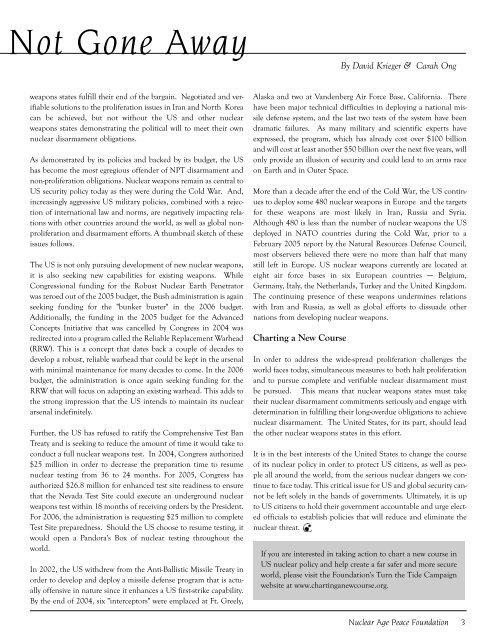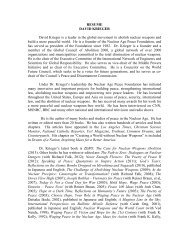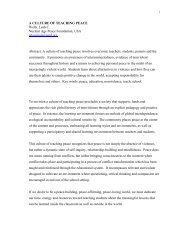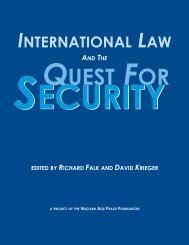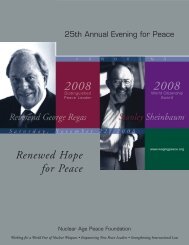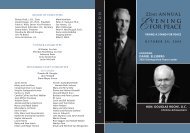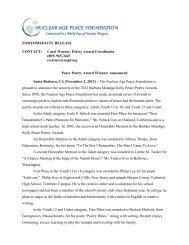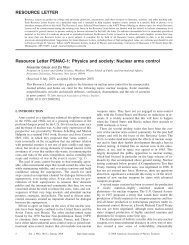Volume 15 - 1 edits.qxd - Nuclear Age Peace Foundation
Volume 15 - 1 edits.qxd - Nuclear Age Peace Foundation
Volume 15 - 1 edits.qxd - Nuclear Age Peace Foundation
- No tags were found...
Create successful ePaper yourself
Turn your PDF publications into a flip-book with our unique Google optimized e-Paper software.
Not Gone AwayBy David Krieger & Carah Ongweapons states fulfill their end of the bargain. Negotiated and verifiablesolutions to the proliferation issues in Iran and North Koreacan be achieved, but not without the US and other nuclearweapons states demonstrating the political will to meet their ownnuclear disarmament obligations.As demonstrated by its policies and backed by its budget, the UShas become the most egregious offender of NPT disarmament andnon-proliferation obligations. <strong>Nuclear</strong> weapons remain as central toUS security policy today as they were during the Cold War. And,increasingly aggressive US military policies, combined with a rejectionof international law and norms, are negatively impacting relationswith other countries around the world, as well as global nonproliferationand disarmament efforts. A thumbnail sketch of theseissues follows.The US is not only pursuing development of new nuclear weapons,it is also seeking new capabilities for existing weapons. WhileCongressional funding for the Robust <strong>Nuclear</strong> Earth Penetratorwas zeroed out of the 2005 budget, the Bush administration is againseeking funding for the "bunker buster" in the 2006 budget.Additionally, the funding in the 2005 budget for the AdvancedConcepts Initiative that was cancelled by Congress in 2004 wasredirected into a program called the Reliable Replacement Warhead(RRW). This is a concept that dates back a couple of decades todevelop a robust, reliable warhead that could be kept in the arsenalwith minimal maintenance for many decades to come. In the 2006budget, the administration is once again seeking funding for theRRW that will focus on adapting an existing warhead. This adds tothe strong impression that the US intends to maintain its nucleararsenal indefinitely.Further, the US has refused to ratify the Comprehensive Test BanTreaty and is seeking to reduce the amount of time it would take toconduct a full nuclear weapons test. In 2004, Congress authorized$25 million in order to decrease the preparation time to resumenuclear testing from 36 to 24 months. For 2005, Congress hasauthorized $26.8 million for enhanced test site readiness to ensurethat the Nevada Test Site could execute an underground nuclearweapons test within 18 months of receiving orders by the President.For 2006, the administration is requesting $25 million to completeTest Site preparedness. Should the US choose to resume testing, itwould open a Pandora's Box of nuclear testing throughout theworld.In 2002, the US withdrew from the Anti-Ballistic Missile Treaty inorder to develop and deploy a missile defense program that is actuallyoffensive in nature since it enhances a US first-strike capability.By the end of 2004, six "interceptors" were emplaced at Ft. Greely,Alaska and two at Vandenberg Air Force Base, California. Therehave been major technical difficulties in deploying a national missiledefense system, and the last two tests of the system have beendramatic failures. As many military and scientific experts haveexpressed, the program, which has already cost over $100 billionand will cost at least another $50 billion over the next five years, willonly provide an illusion of security and could lead to an arms raceon Earth and in Outer Space.More than a decade after the end of the Cold War, the US continuesto deploy some 480 nuclear weapons in Europe and the targetsfor these weapons are most likely in Iran, Russia and Syria.Although 480 is less than the number of nuclear weapons the USdeployed in NATO countries during the Cold War, prior to aFebruary 2005 report by the Natural Resources Defense Council,most observers believed there were no more than half that manystill left in Europe. US nuclear weapons currently are located ateight air force bases in six European countries — Belgium,Germany, Italy, the Netherlands, Turkey and the United Kingdom.The continuing presence of these weapons undermines relationswith Iran and Russia, as well as global efforts to dissuade othernations from developing nuclear weapons.Charting a New CourseIn order to address the wide-spread proliferation challenges theworld faces today, simultaneous measures to both halt proliferationand to pursue complete and verifiable nuclear disarmament mustbe pursued. This means that nuclear weapons states must taketheir nuclear disarmament commitments seriously and engage withdetermination in fulfilling their long-overdue obligations to achievenuclear disarmament. The United States, for its part, should leadthe other nuclear weapons states in this effort.It is in the best interests of the United States to change the courseof its nuclear policy in order to protect US citizens, as well as peopleall around the world, from the serious nuclear dangers we continueto face today. This critical issue for US and global security cannotbe left solely in the hands of governments. Ultimately, it is upto US citizens to hold their government accountable and urge electedofficials to establish policies that will reduce and eliminate thenuclear threat.If you are interested in taking action to chart a new course inUS nuclear policy and help create a far safer and more secureworld, please visit the <strong>Foundation</strong>'s Turn the Tide Campaignwebsite at www.chartinganewcourse.org.<strong>Nuclear</strong> <strong>Age</strong> <strong>Peace</strong> <strong>Foundation</strong> 3


